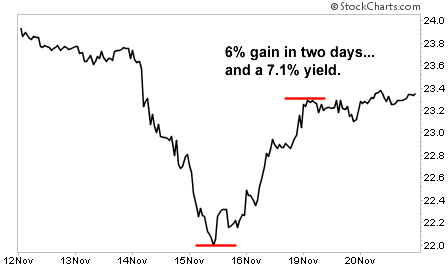The Surprising ‘11% Chart’ Dividend Investors Need to See
I want to show you one of the most interesting charts of the past few weeks.
Two weeks ago, fears over the “fiscal cliff” sent stocks tumbling. In the six trading days following the election, the S&P 500 fell more than 5%. Stocks of all kinds were selling off, regardless of their fundamentals.
The chart below shows a closed-end fund that pays a dividend yield of 7.7% today. The fund invests in hundreds of bonds from around the world. Portfolio holdings include U.S. Treasuries, Brazilian government bonds, South African bonds and others.
The value of these investments doesn’t really change day to day, no matter where the stock market goes. Usually the fund’s price moves only a few cents on any given day.
But look at the opportunity served on a platter to savvy income investors during the sell-off…

Amy Calistri holds this fund — the AllianceBernstein Global High Income Fund (NYSE: AWF) — in her Daily Paycheck real-money portfolio. She’s currently up 31% on the position since buying it back in 2010.
As you can see, in the span of just a day and a half, AWF — a conservative, high-yielding bond fund — fell 10%. But anyone who took the opportunity to buy into that sell-off made up to 11% in just two days. That’s in addition to locking in an 8.6% yield at the low.
But AWF wasn’t some special case.
Take a look at another opportunity to do nearly the same thing, this time with the Reaves Utility Income Fund (NYSE: UTG). This fund pays a yield of 6.7% today, and invests in utilities across the United States. Its largest holding is AT&T (NYSE: T).

Amy also owns UTG in her Daily Paycheck portfolio. It’s one of her favorite holdings and has returned 32%.
The shares gained 6% from their low in just two days. Anyone who bought at the low also locked in a 7.1% yield.
For most people, sell-offs like these two funds went through are frightening. But for Amy, steep drops in these funds signal an opportunity.#-ad_banner-#
In fact, nearly every time there is a large sell-off in the broader market, this opportunity presents itself. But the window to snap up the shares — and lock in a higher yield — is always short-lived.
So what’s going on? Why would funds that pay high yields and hold a basket of conservative holdings sell off so sharply… only to snap back a few days later as if nothing happened?
The key lies in two traits of high-yield funds. First, most of these funds are thinly traded. Second, lots of retirees own these funds.
The Reaves Utility Income Fund trades just 115,000 shares a day. That’s about how many shares of Apple (Nasdaq: AAPL) trade hands in three minutes. The AllianceBernstein Global High Income Fund trades about 215,000 shares.
The low volume means it doesn’t take much selling to move the share price.
And because the funds are popular among retirees — many of whom use stop-losses to automatically sell the shares if they fall (to help protect their nest egg) — all it takes is a slight sell-off to start an entire wave of automatic selling.
This selling is disconnected from any fundamentals. For example, while UTG sold off sharply, the fund’s largest holding — AT&T — fell just 3% during the same time.
But what causes the shares to snap back so quickly?
Unlike a stock, every closed-end fund has a number that tells you exactly how much a share is worth — its net asset value (NAV). Net asset value is the worth of all the fund’s holdings, on a per-share basis. You can find the NAV of any fund at CEFConnect.com.
Simply put, if a fund trades above its NAV, then investors who buy are paying more for a fund than it is actually worth. But there are cases — such as these sharp sell-offs — where a fund will sell for dramatically less than the underlying value of its holdings.
At one point during the sell-off, AWF was trading at a discount of 6% below its net asset value, compared to an average premium of 3%.
This disconnect brings investors rushing back when they see a bargain. Savvy investors who notice the situation can pocket quick gains practically overnight and lock in a great yield.
Of course, this all happens very quickly. Sometimes it happens within hours. But most of the time it happens within one or two days.
This means you need have your favorite high-yield funds on your watch list before a sell-off starts. If you don’t, then the opportunity could pass you by before you even realized it existed.
Action to Take –> Don’t get me wrong, not every closed-end fund that suffers a sell-off is going to rebound accordingly. To better your chances, you have to check its discount or premium to understand when a fund is undervalued compared to its holdings.
But according to Amy, most of the time the sell-offs in high-yield funds are overdone during market panics, offering investors a great chance to pocket quick gains.
At the very least, these panic sell-offs are usually not a reason to sell your shares.
[Note: Income tips like this one put Amy head and shoulders above the competition, in my opinion. If you’re unfamiliar with Amy and her work, then you can learn about her unique “trifecta” approach to dividend investing here. She is on to something. Amy is earning more than $1,300 in monthly income from her portfolio and has collected nearly $40,000 in dividends since 2010. To learn more, visit this link.]
|
|
